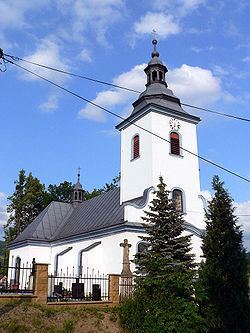Postal code 738 01, 739 94 Elevation 350 m Population 4,015 (2006) Team TJ Vendryně | First mentioned 1305 Website www.vendryne.cz Area 20.95 km² Local time Sunday 3:58 AM | |
 | ||
Weather 11°C, Wind S at 23 km/h, 59% Humidity | ||
Vendryně (Polish: Wędrynia ) is a village in Frýdek-Místek District, Moravian-Silesian Region, Czech Republic, on the banks of the Olza River. It has a population of 3,842 (2001 census), 35.3% of the population are Poles. The village lies in the historical region of Cieszyn Silesia.
Contents
Map of Vendryn%C4%9B, Czechia
The name of the village is of topographic origins derived from the toponimic base *vądr- tentatively connected with water.
History
The settlement was first mentioned in a Latin document of Diocese of Wrocław called Liber fundationis episcopatus Vratislaviensis from around 1305 as item in Wandrina. It meant that the village was in the process of location (the size of land to pay a tithe from was not yet precised). The creation of the village was a part of a larger settlement campaign taking place in the late 13th century on the territory of what will be later known as Upper Silesia.
Politically the village belonged initially to the Duchy of Teschen, formed in 1290 in the process of feudal fragmentation of Poland and was ruled by a local branch of Piast dynasty. In 1327 the duchy became a fee of the Kingdom of Bohemia, which after 1526 became part of the Habsburg Monarchy.
The village became a seat of a Catholic parish, mentioned in the register of Peter's Pence payment from 1447 among 50 parishes of Teschen deanery as Vandrzina. After 1540s Protestant Reformation prevailed in the Duchy of Teschen and a local Catholic church was taken over by Lutherans. It was taken from them (as one from around fifty buildings in the region) by a special commission and given back to the Roman Catholic Church on 21 March 1654.
In the 19th century an iron ore was mined in the village for the iron works in Ustroń and later the Třinec Iron and Steel Works in Třinec. Limestone was mined until 1965.
After Revolutions of 1848 in the Austrian Empire a modern municipal division was introduced in the re-established Austrian Silesia. The village as a municipality was subscribed to the political district of Teschen and the legal district of Jablunkau. According to the censuses conducted in 1880, 1890, 1900 and 1910 the population of the municipality grew from 1,989 in 1880 to 2,587 in 1910 with a majority being native Polish-speakers (between 97.4% and 98.9%) accompanied by German-speaking (at most 62 or 2.4% in 1910) and Czech-speaking people (at most 6 or 0.2% in 1910). In terms of religion in 1910 the majority were Protestants (69%), followed by Roman Catholics (30.5%) and Jews (16 or 0.5%). The village was also traditionally inhabited by Cieszyn Vlachs, speaking Cieszyn Silesian dialect.
After World War I, fall of Austria-Hungary, Polish–Czechoslovak War and the division of Cieszyn Silesia in 1920, it became a part of Czechoslovakia. Following the Munich Agreement, in October 1938 together with the Zaolzie region it was annexed by Poland, administratively adjoined to Cieszyn County of Silesian Voivodeship. It was then annexed by Nazi Germany at the beginning of World War II. After the war it was restored to Czechoslovakia.
From 1980 to 1995 it was administratively a part of the town of Třinec.
Twin towns — Sister cities
Vendryně is twinned with:
